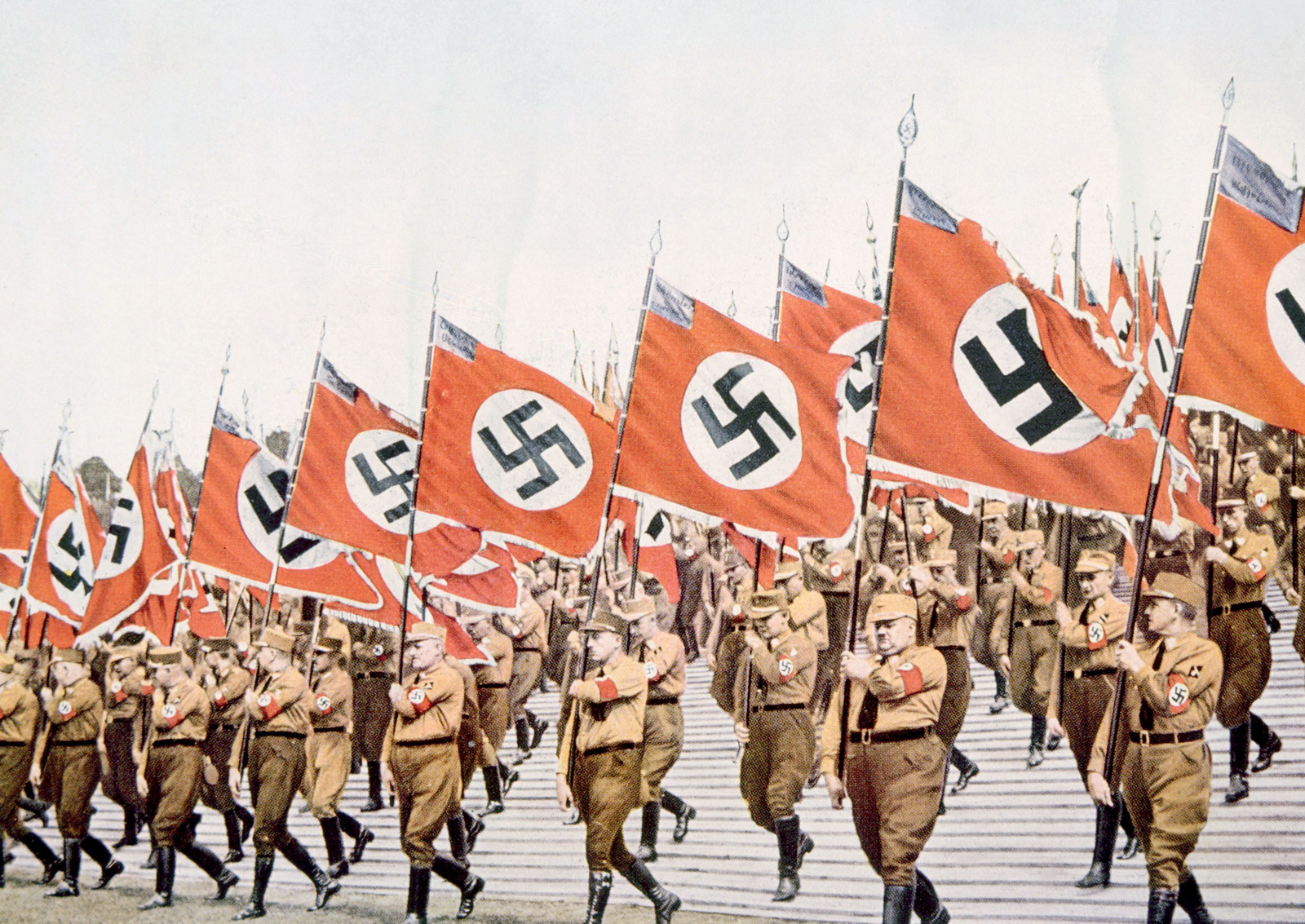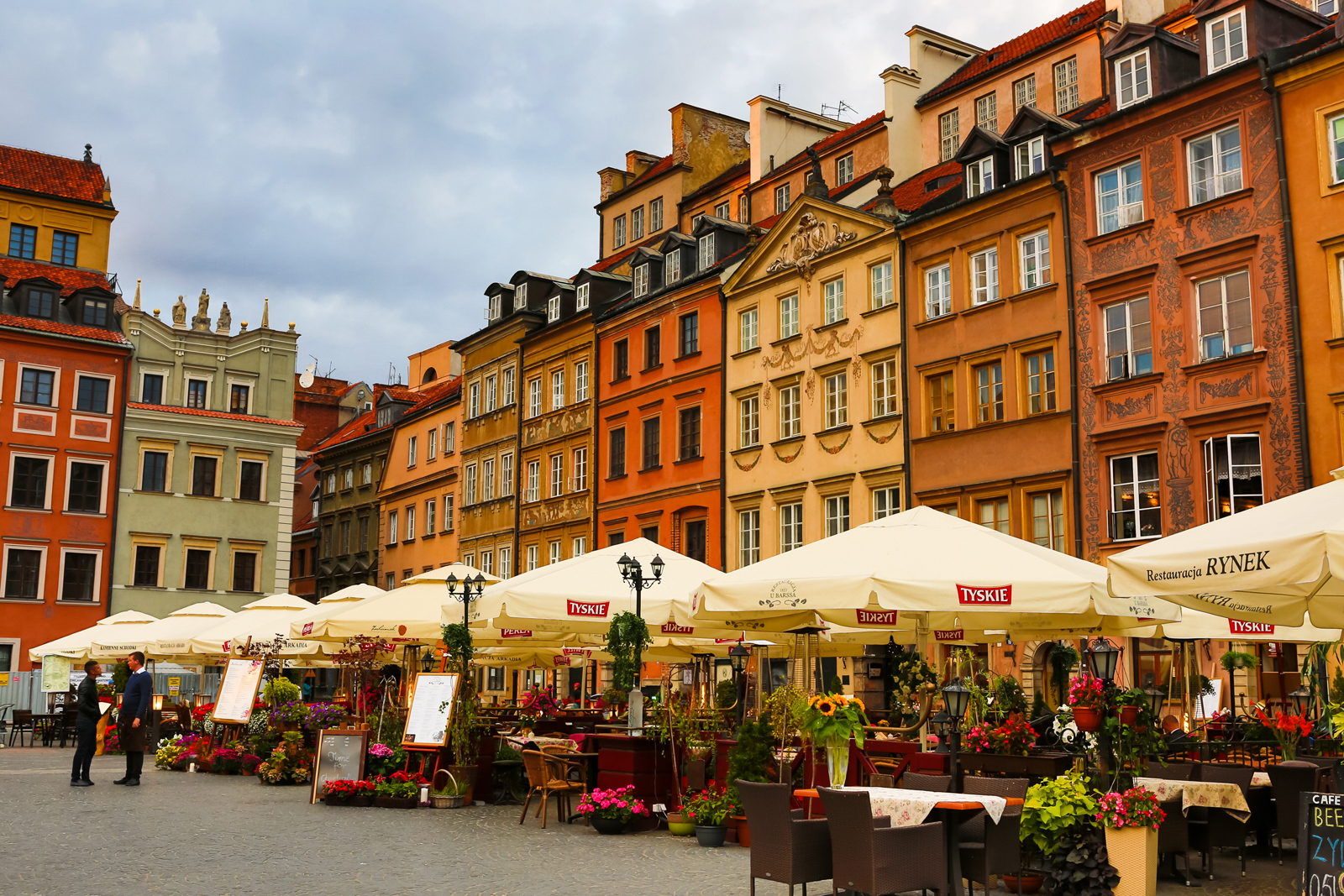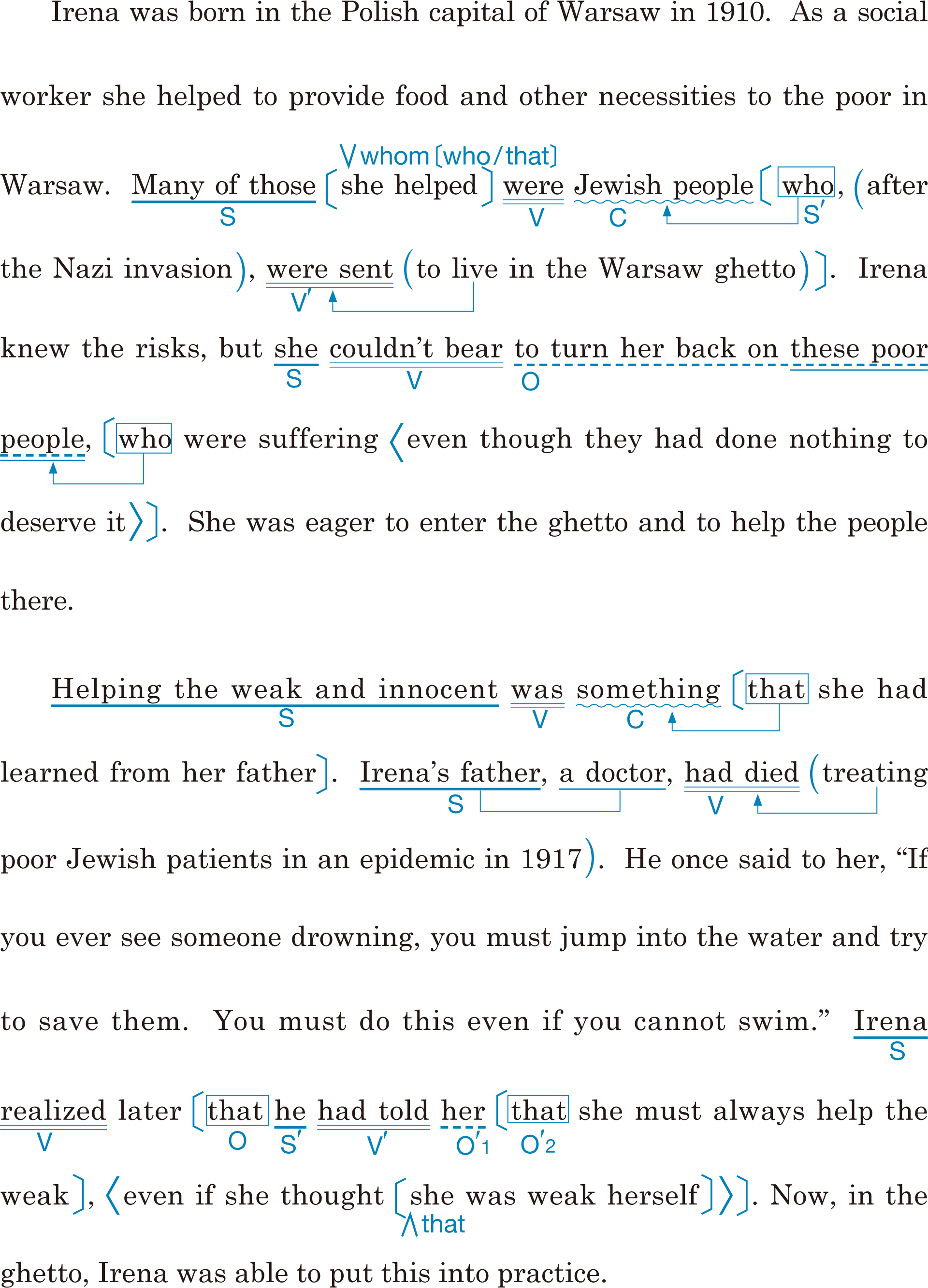READING
Section1
Q What happened in Poland after the Nazis took over the country?

The Nazis invaded Poland in 1939 and World War II broke out in Europe. As the Nazis took over the country, persecution of the Jewish people, which had already begun in Germany, started in Poland, too. All Jewish people, regardless of their age or sex, were made to live in certain areas of the cities known as ghettos. They were forbidden to leave the ghettos and any who tried to do so were killed.
1939 年にナチスがポーランドを侵略して,第二次世界大戦がヨーロッパで勃発しました。ナチスが国の支配権を掌握すると,ユダヤ人の迫害が,それはもうドイツでは始まっていましたが,ポーランドでも始まりました。すべてのユダヤ人は,年齢や性別に関係なく,ゲットーとして知られる,それぞれの都市の特定の地域に住まわされました。彼らはゲットーから出ることを禁止され,そうしようとした者は誰でも殺されました。

- Nazi(s)
- invade(d)
- Poland
- take over
- persecution
- begun(< begin)
- regardless
- regardless of
- sex
- ghetto(s)
- forbidden(< forbid)

Section 1 : True or False ?

(1) T / F
(2) T / F
(1) Persecution of the Jewish people happened first in Poland.[F]
(2) The Jewish people in Poland were taken to the ghettos and could not leave them.[T]
Section2
Q What were the conditions like in the ghettos?

Conditions in the ghettos were very bad. Many of the Jewish people suffered from starvation and disease. As the Nazis regarded the Jewish people as an inferior race, little was done to help them. However, there was a fear that disease might spread from the ghettos to the outside. To keep a check on infections, a very small number of social workers were allowed to enter the ghettos. They were allowed to monitor the situation, but they were not allowed to help. If they helped the Jewish people, it would have meant severe punishment for them and their families. One of these social workers was Irena Sendler.
ゲットーの状況は劣悪でした。ユダヤ人の多くは,飢餓や病気に苦しみました。ナチスがユダヤ人を劣った人種としてみなしたので,彼らの助けるためにされたことはほとんどありませんでした。ところが,病気がゲットーから外側へ広がるかもしれないという心配がありました。伝染病を継続的に調査するために,ほんのわずかな人数のソーシャルワーカーたちがゲットーに入ることを許されました。彼らは状態を監視することは認められました,助けることは認められませんでした。もし彼らがユダヤ人を助けたら、それは本人とその家族に対する厳しい処罰を意味したことでしょう。このようなソーシャルワーカーの1人がイレーナ・センドラーでした。

- starvation
- regard A as B
- inferior
- fear
- infection(s)
- social worker(s)
- monitor
- severe
- Irena Sendler

Section2 : True or False ?

(1) T / F
(2) T / F
(1) In the ghettos, Jewish people did not have enough food.[T]
(2) Social workers who tried to help the Jewish people in the ghettos were punished, but their families weren’t.[F]
Section3
Q Why was Irena eager to help the Jewish people?

Irena was born in the Polish capital of Warsaw in 1910. As a social worker she helped to provide food and other necessities to the poor in Warsaw. Many of those she helped were Jewish people who, after the Nazi invasion, were sent to live in the Warsaw ghetto. Irena knew the risks, but she couldn’t bear to turn her back on these poor people, who were suffering even though they had done nothing to deserve it. She was eager to enter the ghetto and to help the people there.
Helping the weak and innocent was something that she had learned from her father. Irena’s father, a doctor, had died treating poor Jewish patients in an epidemic in 1917. He once said to her, “If you ever see someone drowning, you must jump into the water and try to save them. You must do this even if you cannot swim.” Irena realized later that he had told her that she must always help the weak, even if she thought she was weak herself. Now, in the ghetto, Irena was able to put this into practice.
イレーナは,1910年,ポーランドの首都ワルシャワで生まれました。ソーシャルワーカーとして,彼女は貧しい人々の食べ物や生活必需品を提供する手伝いをしてきました。彼女が助けた人々の多くはユダヤ人で,彼らはナチスの侵略のあと,ワルシャワのゲットーに住まわされていました。イレーナは危険を知っていましたが,これらのかわいそうな人々に背を向けることは耐えられなかったのです。彼らは,それに値することは何もしていなかったのに苦しんでいるのですから。彼女はゲットーに入り,そこにいる人々を是非助けたいと思っていました。
か弱く罪のない人々を助けることは,彼女が自分の父親から学んだことでした。イレーナの父親は医者でしたが,1917年の病気の流行中に,貧しいユダヤ人の患者たちを治療していて亡くなりました。彼はかつてイレーナに言いました。「もしいつか,誰かがおぼれているのを見たら,水に飛び込んで彼らを助けようとしなければならないよ。たとえばおまえが泳げなくても,そうしなければならないのだ。」後にイレーナは,たとえ彼女が自分自身は弱いと考えたとしても,いつも弱い人を助けなければならないことを父が自分に教えたのだと理解しました。今,ゲットーの中でイレーナはこれを実行に移すことができたのです。

- Polish
- Warsaw ワルシャワ(ポーランドの首都)
- necessity,necessities
- invasion
- risk(s)
- bear
- turn one’s back on
- eager
- be eager to do
- weak
- innocent
- epidemic
- put ~ into practice

Section3 : True or False ?

(1) T / F
(2) T / F
(3) T / F
(1) Irena Sendler helped poor people in Warsaw.[T]
(2) Irena had to give up helping the Jewish people after they were sent to the Warsaw ghetto.[F]
(3) Irena’s father taught her the value of helping the weak even if she thought she was weak herself.[T]
Section4
Q What did Irena decide to do in spite of the many risks she faced?

Some of the weakest people in the ghettos were the children and it was the children that Irena and several others decided to save. This was extremely risky and extremely difficult. First, all exits from the ghetto were watched. Second, anyone leaving was thoroughly searched. Finally, anyone caught helping Jewish people was shot. Irena and several others decided that in spite of this they would work together to take children secretly out of the ghetto to safety. Irena helped over 1,250 children to escape. Children were hidden in boxes and bags. They were carried out of the ghetto under piles of vegetables and among old clothes. Some small children were even taken out of the ghetto hidden under Irena’s skirt.
ゲットーの中で最も弱い人々の一部は子供たちだったので,イレーナほか何人かが救おうと決めたのは子供たちでした。これはきわめて危険で,きわめて困難なことでした。第一に,ゲットーからのすべての出口は見張られていました。第二に,出て行く者は誰もが徹底的に調べられました。最後に,ユダヤ人を助けているところを見つかった者は誰もが射殺されたのです。イレーナをはじめとする何人かはこのことにもかかわらず,協力して子供たちをひそかにゲットーから安全なところへ連れて行こうと決めました。イレーナは 1,250 人を超える子供たちが逃げるのを助けました。子供たちは箱や袋の中に隠されました。彼らは,積み上げられた野菜の下や古着の中に隠れて,ゲットーから運び出されました。小さな子供たちの中には,イレーナのスカートの中に隠されてゲットーから連れ出された子さえいました。

- extremely
- risky
- thoroughly
- safety
- pile(s)

Section4 : True or False ?

(1) T / F
(2) T / F
(3) T / F
(1) Irena and several others decided that they should save all the people in the ghetto.[F]
(2) It was not very difficult to take children out of the ghetto.[F]
(3) Irena used boxes, bags and old clothes to save children from the ghetto.[T]
Section5
Q How did Irena save the girl when she began coughing?

On one occasion Irena had a little girl hidden under the back seat of her car. Irena told her to be silent. She was very good, even though she was very sick with a cough. However, as they were leaving the ghetto, the car was stopped by some Nazi soldiers. Irena sat in silence while the soldiers checked the trunk and under the car. Just then, the little girl started to cough. The poor child tried to stop, but she coughed and coughed. Surely she would be discovered! What should Irena do? Was this the end?
“What is that?” one of the soldiers said, and then looked with concern at Irena. She was coughing loudly and continuously. “You need to see a doctor!” he said. He told her that she should be careful. He said that she might catch a bad disease from “those dirty Jews.” “Thank you,” Irena said to the soldier, and drove out of the ghetto. The child was safe.
ある時,イレーナはある少女を彼女の車の後部座席の下に隠していました。イレーナは彼女に静かにしているように言いました。彼女はせきでとても具合が悪かったにもかかわらず,とてもいい子にしていました。ところが,彼女たちがゲットーを出発しようとした時,何人かのナチスの兵士に車を止められました。兵士たちがトランクや車の下を調べている間,イレーナは黙って座っていました。ちょうどその時,少女がせきをし始めたのです。かわいそうなその子供はせきを止めようとしましたが,せきこみ続けました。きっと彼女は発見されしまうでしょう!イレーナは何をするべきでしょうか。これで終わりなのでしょうか。
「あれは何だ?」と兵士の1人が言い,それから心配してイレーナを見ました。彼女は大きな声で立て続けにせきをしていました。「おまえは医者に診てもらう必要がある!」と彼は言いました。兵士は彼女に,気をつけるようにと言いました。彼は,彼女が「あの汚れたユダヤ人たち」から悪い病気に感染するかもしれないと言ったのです。イレーナはその兵士に「ありがとう」と言い,ゲットーから車で走り去りました。子供は無事でした。

- trunk
- continuously
- Jew(s)

Section5 : True or False ?

(1) T / F
(2) T / F
(3) T / F
(1) Irena hid the little girl inside the trunk of her car.[F]
(2) The little girl began to cry because Nazi soldiers stopped Irena’s car.[F]
(3) One of the soldiers saw Irena coughing loudly and told her to see a doctor.[T]
Section6
Q What happened to Irena in 1943?

Irena’s luck did not last much longer. In 1943 she was arrested by the Nazis. They questioned her about the Jewish children, but she told them nothing. They tortured her, but even under immense pain and suffering she still wouldn’t tell them anything at all. Finally, her friends came to the rescue. In exchange for money, one of her guards agreed to let her escape. For her own safety she was hidden, but even from her hiding place she still managed to help children. It is said that she ultimately helped some 2,500 children.
イレーナの幸運はそう長くは続きませんでした。1943年,彼女はナチスに逮捕されました。彼らは彼女にユダヤ人の子供たちについて尋問しましたが,彼女は何も言いませんでした。彼らは彼女を拷問にかけましたが,すさまじい痛みと苦しみを受けてもなお,彼女はまったく何も言おうとしなかったのです。ついに,彼女の友人たちが救出に来ました。お金と引き換えに,彼女の監視人の1人が彼女を逃がすことに同意しました。彼女自身の安全のために彼女はかくまわれましたが,その隠れ場所からでさえ,彼女はまだどうにかして子供たちを助けました。彼女は最終的におよそ2,500人の子供たちを助けたと言われています。

- torture(d)
- immense
- suffering
- rescue
- come to the rescue
- in exchange for
- guard(s)
- hiding place
- ultimately

Section6 : True or False ?

(1) T / F
(2) T / F
(1) The Nazis got information about the children from Irena.[F]
(2) Even from her hiding place, Irena continued to help Jewish children.[T]
Section7
Q What did Irena make for the children she saved?

So what happened to all the children that Irena saved? They were taken to religious institutions and to Polish families. Kind, brave people adopted the children and gave them false identities. For many years, during and after the war, the children grew up as non-Jewish, Polish citizens. Most of them had lost everything, including their whole families. However, Irena understood that it was vital that the children didn’t lose their pasts. They had to know who they were and where they had come from. She made a list of as many children as possible, with their real names, ages, and other information. She hid it in a jar and buried it in the ground so that they could learn about themselves and their families after the war ended.
さてそういうことで,イレーナが救ったすべての子供たちには何が起きたのでしょうか。彼らは,宗教施設やポーランド人の家庭へ連れて行かれました。親切で勇気ある人々が子供たちを養子にして,彼らに偽りの身元を与えたのです。戦中戦後にわたる何年もの間,子供たちは非ユダヤのポーランド市民として成長しました。彼らの大半は,家族の全員を含めて何もかもを失いました。しかしイレーナは,子供たちが彼らの過去を失わないことが大変重要であると思っていました。彼らは自分たちが誰であり,どこから来たのかを知らなければなりませんでした。彼女は,できる限り多くの子供たちの本当の名前,年齢やその他の情報を載せた名簿を作りました。彼女は,戦争が終わった後,子供たちが自分たちや家族のことを知ることができるように,それをびんに入れて地中に埋めたのです。

- religious
- institution(s)
- adopt(ed)
- identity, identities
- grow up
- non-Jewish
- citizen(s)
- vital
- jar
- bury, buried

Section 7 : True or False ?

(1) T / F
(2) T / F
(1) Some of the children that Irena saved were adopted and grew up with false identities.[T]
(2) Irena wanted the children to forget all about their pasts.[F]
Section8
Q Why did Irena feel irritated when people called her a ‘hero’?

The children Irena saved called themselves “Irena’s children” and were proud of their hero “mother.” Irena, however, didn’t see herself as a hero at all. “The term ‘hero’ irritates me greatly,” she said in an interview many years after the war. “The opposite is true ... I did so little.” Irena finally saved the lives of some 2,500 children and yet said she had done so little. Do you think she was a hero?
イレーナが救った子供たちは,自分たちを「イレーナの子供たち」とよび,彼らの英雄的な「母」を誇りに思っていました。しかしイレーナは,自分自身を英雄であるとはまったく思っていませんでした。「『英雄』という言葉は私をとてもいらいらさせます」と,戦後何年もたってからインタビューで彼女は言いました。「その反対が真実なのです…。私はほとんど何もしていません。」イレーナは,およそ 2,500 人の子供たちの命を救いましたが,それでもまだ彼女はほとんど何もしなかったと言ったのです。あなたは彼女が英雄だったと思いますか。

- term
- irritate(s)

Section 8 : True or False ?

(1) T / F
(2) T / F
(1) Irena called the children she saved “Irena’s children.”[F]
(2) Irena didn’t think she was a ‘hero.’.[T]

















